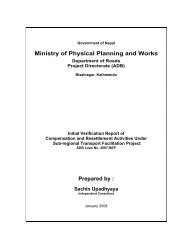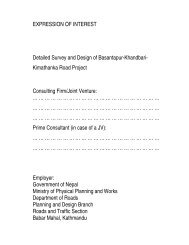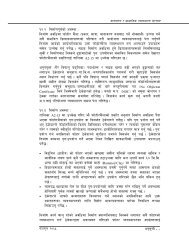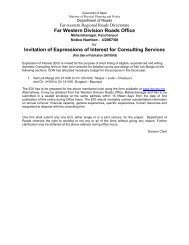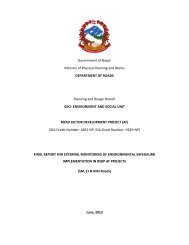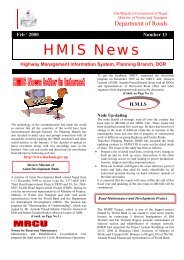Environmental & Social Management Framework - About ...
Environmental & Social Management Framework - About ...
Environmental & Social Management Framework - About ...
Create successful ePaper yourself
Turn your PDF publications into a flip-book with our unique Google optimized e-Paper software.
<strong>Environmental</strong> and <strong>Social</strong> <strong>Management</strong> <strong>Framework</strong>e.g. on vulnerable soils where frequent effects are scouring, gullying, bank cuttingand soil erosion. The dramatic final effect of these incremental impacts usuallycumulates in massive landslides, which in turn can cause slope instability andlandslides. In absence of proper water management a concentrated flow can leadto scouring, gullying and soil erosion at downstream land, which in turn cancause slope instability and trigger landslides. The effects of disruption can extendwell beyond the immediate vicinity of a road or point sources of any immediateimpact (e.g. spoil deposit, see example, Box 3).Box 3Case Examples demonstrating Water Flow Disruption and unsafe SpoilDepositfollowing Road Development in NepalWidening of the Naubise-Mugnling road gave rise to large quantities of spoil, whichwere left hanging on the steep slopes below the road in many sections. Heavy rainin 1991 and 1993 triggered a number of mass slump failures, where the slopecollapsed on a plane below the original ground, taking part of the road with it. Thiscould have been easily avoided if the debris had been simply pushed down theslopes into the river below. Similar problems have occurred on the sites on thePokhara-Baglung, Bhalubang-Pyuthan and Syauli-Silgadi roads.Gullying in fresh, tipped debris is generally common in recently constructed roads,where spoil is side-tipped without proper spoil management. The Kamphek-Rajaraniand Baitadi-Darchula roads, both of which have alignment sections near the top ofvery long steep slopes , are probably the worst examples. Other examples of roadshaving similar problems are Mugling-Marsyangdi, Butwal-Tansen, Pokhara-Baglung,Sahajpur-Dadeldhura, Silghadi-Sanfe Bagar, Khodpe-Bajhang, and Baitadi-Darchula roads.Side tipping on the steep Mahabharat slopes crossed by the Surkhet – Dailekh roadled to disruption to the Surkhet Water Supply, which has been a well knownexample of problem of spoil disposal.In Terai, road embankment often acts like a low height dam across agriculture fields.In the absence of adequate cross drainage structures, water ponding, water loggingand flooding on upstream command area occurs, often damaging road itself as wellas land and property.Source: Briefing Paper on <strong>Environmental</strong> Issues and <strong>Environmental</strong> Assessment in Road Sector, RAP, 1999Roads can act as low height dams and cause disruption of natural drainage,water logging, water pounding, flooding. In the Terai plains, for example, theconcentration of water from an impermeable road surface, via side drains to aconcentrated flow in a gully is an acute hazard. In the Silgadhi-Sanfebagar,Surkhet-Dailekh, Baitadi-Darchula, Pokhara-Baglung and Basantpur-Terhathumroads, inadequate drainage provision around hairpin stacks has led to extensivegullying which has led to widespread damage both to the road itself and toadjacent lands.Stagnant pools of water or water-logged depressions as well as abandonedborrow pits may become a vector breeding area thereby causing incrementalimpacts on public health, e.g. spread of malaria and dengue fever.Common problems likely to be encountered in Nepal's rural roads are terminationof road drains on agricultural land which gets damaged by silt and graveldeposits, creation of new water bodies in the borrow pits, and flooding of farmsand settlements because of inadequate number of culverts and their improperplacing (particularly in Terai and in the upstream side of the embankments).April 2007 Chapter 4-11



![j:6 ]zg cfof ]hgf](https://img.yumpu.com/51286794/1/190x245/j6-zg-cfof-hgf.jpg?quality=85)

![x'nfsL /fhdfu { cfof ]hgf](https://img.yumpu.com/50581959/1/190x245/xnfsl-fhdfu-cfof-hgf.jpg?quality=85)
